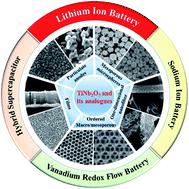当前位置:
X-MOL 学术
›
J. Mater. Chem. A
›
论文详情
Our official English website, www.x-mol.net, welcomes your
feedback! (Note: you will need to create a separate account there.)
Micro/nanostructured TiNb2O7-related electrode materials for high-performance electrochemical energy storage: recent advances and future prospects
Journal of Materials Chemistry A ( IF 10.7 ) Pub Date : 2020-08-01 , DOI: 10.1039/d0ta04209a Hongkang Wang 1, 2, 3, 4, 5 , Ruifeng Qian 1, 2, 3, 4, 5 , Yonghong Cheng 1, 2, 3, 4, 5 , Hong-Hui Wu 6, 7, 8, 9, 10 , Xianwen Wu 10, 11, 12, 13 , Kunming Pan 10, 14, 15, 16, 17 , Qiaobao Zhang 10, 18, 19, 20, 21
Journal of Materials Chemistry A ( IF 10.7 ) Pub Date : 2020-08-01 , DOI: 10.1039/d0ta04209a Hongkang Wang 1, 2, 3, 4, 5 , Ruifeng Qian 1, 2, 3, 4, 5 , Yonghong Cheng 1, 2, 3, 4, 5 , Hong-Hui Wu 6, 7, 8, 9, 10 , Xianwen Wu 10, 11, 12, 13 , Kunming Pan 10, 14, 15, 16, 17 , Qiaobao Zhang 10, 18, 19, 20, 21
Affiliation

|
The increasing demand for large-scale electrochemical energy storage, such as lithium ion batteries (LIBs) for electric vehicles and smart grids, requires the development of advanced electrode materials. Ti–Nb–O compounds as some of the most promising intercalation-type anode materials have attracted a lot of attention owing to their high theoretical capacity (388–399 mA h g−1) arising from the multiple redox pairs (Ti4+/Ti3+, Nb5+/Nb4+, and Nb4+/Nb3+), high safety, and superior cycling stability. However, their intrinsic low electronic conductivity and slow solid-state ion diffusion lead to unsatisfactory rate performance. To overcome these drawbacks, various efficient strategies have been proposed to improve the performance of Ti–Nb–O compounds, especially TiNb2O7. This Review aims to provide rational understanding of how structural engineering approaches (e.g., dimensional/morphological control, doping/hybridizing with exotic elements/components, carbon coating/compositing, etc.) improve the electrochemical properties of micro/nanostructured TiNb2O7-based anode materials. In addition, other Ti–Nb–O compounds with different compositions as anodes for LIBs and micro/nanostructured TiNb2O7-based anodes for other energy storage systems (sodium-ion batteries, hybrid supercapacitors, and vanadium redox flow batteries) are discussed. Finally, the challenges and opportunities for micro/nanostructured TiNb2O7-related electrode materials for high-performance energy storage applications are highlighted.
中文翻译:

用于高性能电化学能量存储的与微米/纳米结构TiNb2O7相关的电极材料:最新进展和未来前景
对大规模电化学储能的需求不断增长,例如用于电动汽车和智能电网的锂离子电池(LIB),需要开发先进的电极材料。Ti-Nb-O化合物作为一些最有前景的插层型阳极材料,由于其由多个氧化还原对(Ti 4+ / Ti )产生的高理论容量(388-399 mA hg -1)而备受关注。3+,Nb 5+ / Nb 4+和Nb 4+ / Nb 3+),高安全性和出色的循环稳定性。然而,它们固有的低电子电导率和缓慢的固态离子扩散导致速率性能不令人满意。为了克服这些缺点,已经提出了各种有效的策略来提高Ti–Nb–O化合物(尤其是TiNb 2 O 7)的性能。本综述旨在提供对结构工程方法(例如尺寸/形态控制,掺杂/杂化元素/组分的杂化,碳涂层/复合等)的合理理解,以改善微/纳米结构TiNb 2 O 7的电化学性能。基阳极材料。此外,还讨论了其他组成不同的Ti-Nb-O化合物作为LIB的阳极,以及其他储能系统(钠离子电池,混合超级电容器和钒氧化还原液流电池)的基于微/纳米结构的TiNb 2 O 7的阳极。 。最后,重点介绍了用于高性能能量存储应用的与微米/纳米结构的TiNb 2 O 7相关的电极材料所面临的挑战和机遇。
更新日期:2020-09-22
中文翻译:

用于高性能电化学能量存储的与微米/纳米结构TiNb2O7相关的电极材料:最新进展和未来前景
对大规模电化学储能的需求不断增长,例如用于电动汽车和智能电网的锂离子电池(LIB),需要开发先进的电极材料。Ti-Nb-O化合物作为一些最有前景的插层型阳极材料,由于其由多个氧化还原对(Ti 4+ / Ti )产生的高理论容量(388-399 mA hg -1)而备受关注。3+,Nb 5+ / Nb 4+和Nb 4+ / Nb 3+),高安全性和出色的循环稳定性。然而,它们固有的低电子电导率和缓慢的固态离子扩散导致速率性能不令人满意。为了克服这些缺点,已经提出了各种有效的策略来提高Ti–Nb–O化合物(尤其是TiNb 2 O 7)的性能。本综述旨在提供对结构工程方法(例如尺寸/形态控制,掺杂/杂化元素/组分的杂化,碳涂层/复合等)的合理理解,以改善微/纳米结构TiNb 2 O 7的电化学性能。基阳极材料。此外,还讨论了其他组成不同的Ti-Nb-O化合物作为LIB的阳极,以及其他储能系统(钠离子电池,混合超级电容器和钒氧化还原液流电池)的基于微/纳米结构的TiNb 2 O 7的阳极。 。最后,重点介绍了用于高性能能量存储应用的与微米/纳米结构的TiNb 2 O 7相关的电极材料所面临的挑战和机遇。











































 京公网安备 11010802027423号
京公网安备 11010802027423号